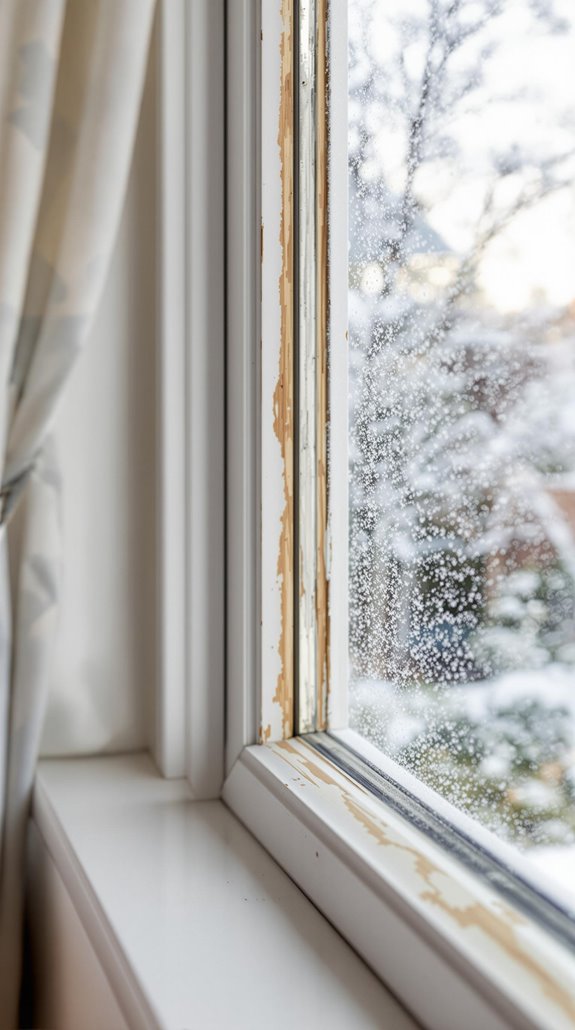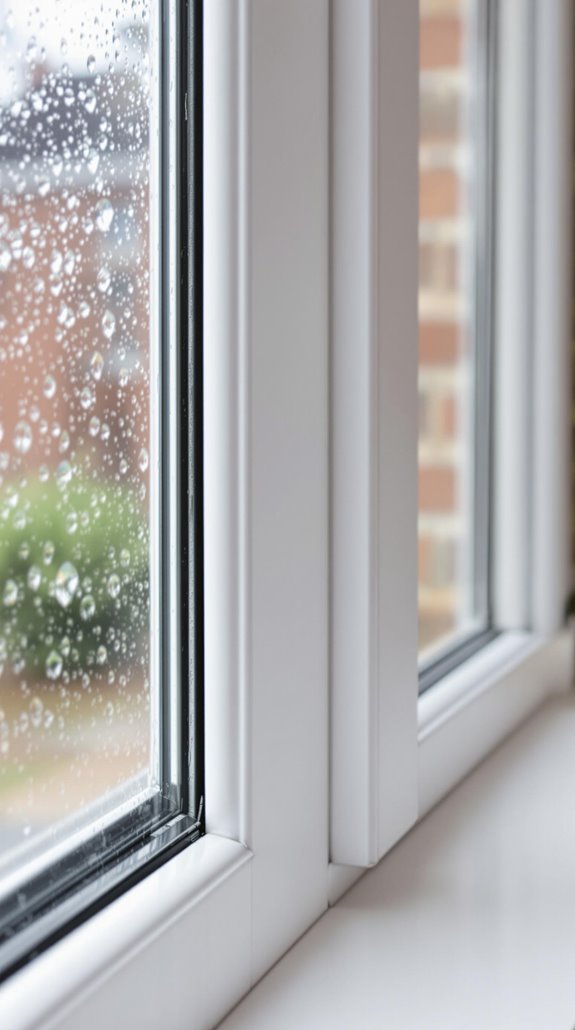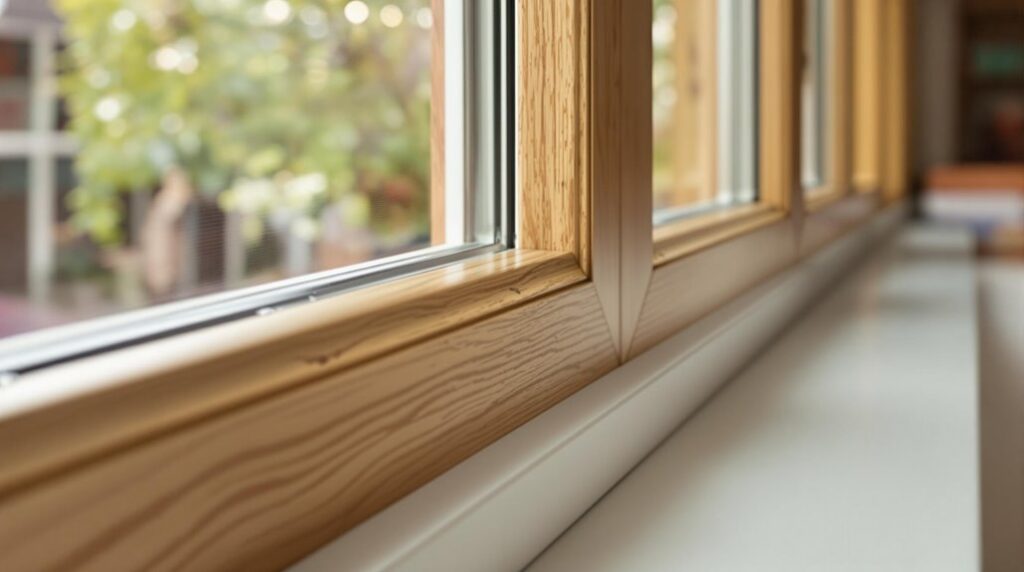I’ve discovered that proper window caulking can slash your heating bills by up to £50 annually—but only if you’re using the right materials and techniques for Britain’s unpredictable climate. Most homeowners make critical mistakes during application that actually worsen energy efficiency. I’ll walk you through the precise tools you’ll need, from silicone sealants to backing rods, and explain why timing your caulking project around UK weather patterns determines whether your investment pays off or fails completely.
Key Takeaways
- Windows account for 18% of total heat loss in UK properties, with single-glazed units losing heat twice as fast as double-glazed.
- Professional window caulking eliminates drafts and can reduce annual energy bills by £50-£95 depending on your property type.
- Proper sealing reduces air leakage by 20% and contributes to 10-15% savings on long-term energy expenses.
- Best caulking materials for UK climate include silicone, acrylic latex, butyl rubber, and polyurethane hybrids for weather resistance.
- Annual inspections and replacement every 3-5 years for exterior caulk ensures continued thermal performance and energy savings.
Understanding Heat Loss Through UK Windows

When examining your home’s energy efficiency, windows represent the single largest thermal vulnerability, accounting for 18% of total heat loss in UK properties. I’ll break down the three primary heat transfer mechanisms you’re dealing with: conduction through glass and frames, convection currents around window perimeters, and radiation that penetrates single-pane installations.
Your single-glazed windows lose heat twice as fast as double-glazed units, contributing to the 24% of residential heat lost through draughty openings. Poor seals and gaps around your window frames permit air leakage, accelerating energy dissipation and creating cold drafts that destabilize indoor temperatures. The scale of this problem becomes apparent when you consider that 98% of UK windows would not meet current energy standards if installed today. Additionally, addressing this issue can lead to significant energy savings in your overall heating costs.
Understanding these thermal pathways helps you identify where targeted caulking interventions will deliver maximum energy savings and improved comfort levels.
Benefits of Professional Window Caulking
Professional window caulking delivers measurable energy efficiency gains that directly address the thermal vulnerabilities I’ve outlined. When you implement proper caulking techniques, you’re eliminating 18% of total home heat loss that occurs through poorly sealed windows. This translates to £50 annual savings on your energy bills. Additionally, these savings are a direct result of reducing energy waste, which is a key principle in energy efficiency.
I’ll guide you through the extensive benefits you’ll achieve. First, waterproof formulations create airtight seals that prevent drafts and maintain consistent indoor temperatures. Second, you’re blocking moisture infiltration that causes structural deterioration and mold growth. Third, reinforced window frames enhance security by eliminating gaps that compromise locking mechanisms. Professional caulking also provides sound insulation benefits by sealing gaps that allow external noise to penetrate your home.
The long-term value you’ll gain includes extended window lifespan, reduced maintenance costs, and improved EPC ratings. These measurable improvements boost your property value while meeting UK building sustainability standards.
Energy and Cost Savings From Proper Sealing
Through proper window sealing techniques, you’ll achieve quantifiable energy savings that directly impact your heating and cooling costs. I’ve observed that properly sealed windows eliminate drafts, maintaining consistent indoor temperatures year-round. You’ll reduce heating needs in winter and cooling demands in summer by preventing air infiltration. In fact, proper insulation can further enhance these savings by minimizing heat loss through walls and roofs.
For mid-terrace homes, you can expect £75 annual savings, while semi-detached properties see £95 yearly reductions. I recommend focusing on eliminating leaky window areas that cause heat escape during winter months. Your caulking gun becomes essential for creating airtight seals around window frames.
Over five years, you’ll accumulate £425 in savings for mid-terrace houses, reaching £850 over ten years. These sealed windows reduce your heating and cooling system workload, translating to lower energy bills. You’re joining homeowners who’ve discovered that proper caulking delivers measurable financial returns. Since nearly 35% of residential heating and cooling energy is lost through windows, your sealing efforts address one of the most significant sources of energy waste in your home.
Carbon Emission Reductions Through Window Efficiency
While improving your home’s energy efficiency reduces utility bills, window sealing delivers substantial carbon emission reductions that contribute to national climate targets. Buildings account for approximately one-fifth of the UK’s total emissions, making your caulking efforts part of a critical sector for decarbonization.
When you properly seal windows with quality caulk and weatherstripping, you’re joining a movement that’s already reduced UK building emissions by one-third since 1990. Your sealed windows complement regulatory advances like the Future Homes Standard’s triple glazing requirements and support the broader push toward energy-efficient glazing with low U-values. Additionally, implementing draft-proofing measures can further enhance your home’s insulation, leading to even greater energy savings.
Each properly sealed window reduces heating demand, directly cutting your home’s carbon footprint. As fellow homeowners embrace these efficiency measures, we’re collectively maintaining the downward trajectory in national emissions while creating more comfortable living spaces. With UK emissions now 53% below 1990 levels while the economy has grown by 82%, your energy efficiency improvements demonstrate how environmental progress and economic growth can work together.
Best Caulking Materials for UK Climate Conditions

Given the UK’s challenging climate conditions—ranging from freezing winters to humid summers with frequent rainfall—selecting the right caulking material becomes essential for long-term window sealing performance.
I’ll guide you through the most effective options for our climate. Silicone caulk stands as the premium choice, withstanding extreme temperature fluctuations while maintaining UV resistance and flexibility. For paintable applications, acrylic latex caulk offers moderate flexibility and easy cleanup—perfect for DIY installations. Properly installed caulking can help maintain the integrity of your damp proof course, preventing moisture issues in the home.
Butyl rubber caulk excels with superior adhesion to brick and stone, handling substantial joint movement in period properties. Polyurethane hybrids combine silicone’s weather resistance with latex’s paintable properties. Professional glazing services are recommended for larger projects requiring extensive sealing work.
Remember: surface preparation remains critical—clean and dry surfaces before application. Apply during dry conditions above 5°C for ideal curing and long-term performance.
Step-by-Step Window Sealing Process
Having selected the appropriate caulking material for your UK climate conditions, proper application technique determines whether your window sealing delivers lasting energy savings or requires costly reapplication within months.
I’ll walk you through the precise method that fellow energy-conscious homeowners use for professional results. First, scrape away old sealant completely using a utility knife, then degrease the frame thoroughly. Load your caulking gun and cut the nozzle at a 45-degree angle matching your joint width.
Apply steady, continuous pressure while maintaining consistent speed along the frame. Hold the gun at 45 degrees for ideal bead control. Immediately smooth the fresh caulk using a wet finger or silicone tool, pushing firmly against both surfaces.
Remove masking tape while wet, then allow 24-hour curing time before testing your improved thermal barrier. Remember to leave the bottom unsealed to allow proper drainage and prevent water damage to your window frame.
Maintenance and Long-Term Performance Tips
Even with perfect application technique, your window caulk won’t deliver lasting energy savings unless you establish a systematic maintenance routine. I’ll walk you through the essential steps we use to maximize performance.
Inspect your caulking annually using both visual checks and manual tests—press the caulk to detect brittleness or separation from surfaces. Early detection of damp issues can also help maintain the integrity of your caulk. Replace exterior caulk every 3–5 years due to UV exposure and temperature fluctuations, while interior caulk lasts 5+ years unless mold appears. Interior caulk may face additional challenges from condensation and mold growth that can compromise its effectiveness.
Prioritize immediate resealing when you notice draughts or moisture infiltration, regardless of application date. After extreme weather events, conduct thorough inspections focusing on potential failure points.
This systematic approach reduces air leakage by up to 20% and saves 10–15% on long-term energy expenses while extending your window’s lifespan.
Conclusion
I’ve outlined the essential technical procedures for achieving ideal window sealing performance in UK conditions. You’ll need quality polyurethane or silicone-based caulk, a caulk gun, smoothing tools, and proper surface preparation materials. Follow each step methodically—clean surfaces, apply consistent beads, tool smooth joints, and cure according to manufacturer specifications. Monitor seal integrity annually and reapply when deterioration occurs. These systematic approaches will deliver measurable energy savings and sustained thermal performance improvements.
References
- https://www.buildingconservation.com/articles/thermal/thermal.htm
- https://www.greenmatch.co.uk/windows/statistics
- https://nu-scene.com/blog/a-guide-to-heat-loss-when-installing-glazing-in-the-uk/
- https://energysavingtrust.org.uk/advice/windows-and-doors/
- https://www.oxera.com/wp-content/uploads/2018/03/Policies-for-energy-efficiency-in-the-UK-household.pdf
- https://www.ggf.org.uk/myglazing/news/98-of-homes-are-losing-energy-through-underperforming-windows/
- https://www.glazingrefurbishments.co.uk/blog/reduce-heat-loss-through-windows
- https://total-installer.co.uk/98-of-uk-homes-are-losing-energy-through-underperforming-windows/
- https://www.albanywindows.co.uk/news/what-are-the-best-windows-to-keep-heat-in/
- https://assets.publishing.service.gov.uk/media/5a802d7aed915d74e33f8e80/DECC_factsheet_11.11.16_GLAZING_LOCKED.pdf

